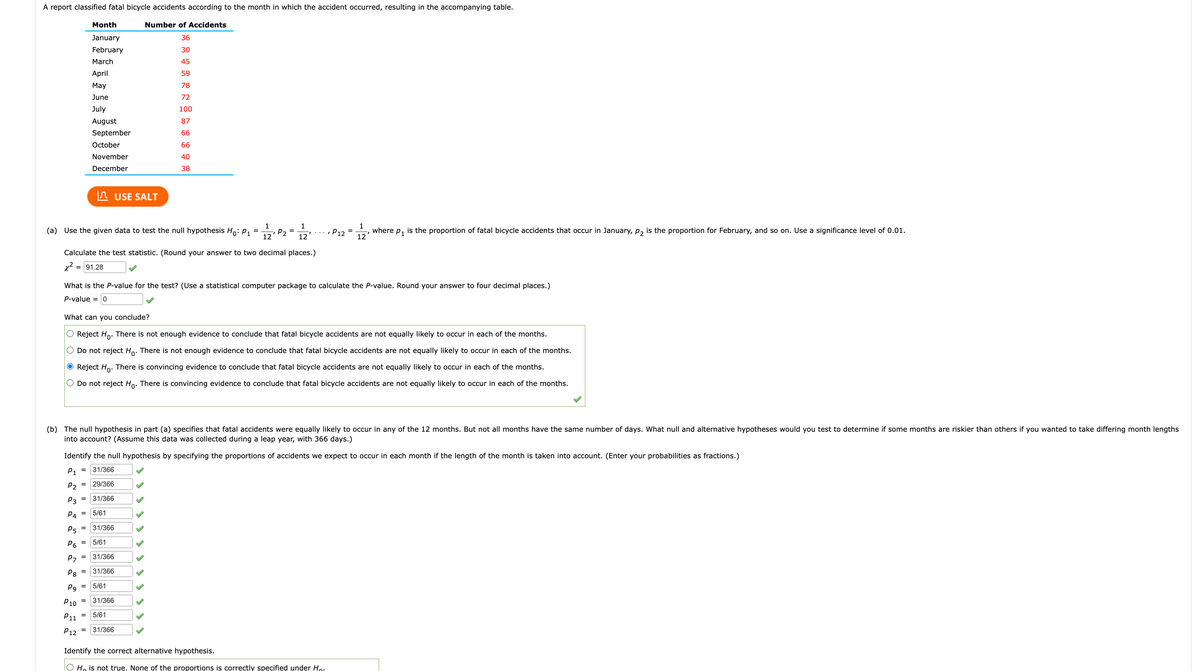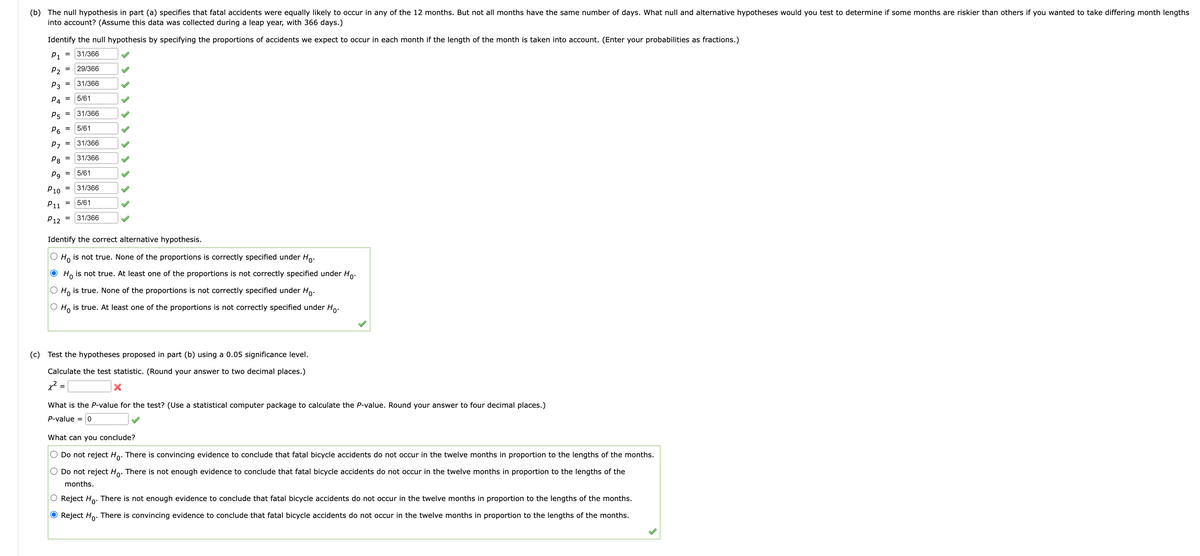Month January February March April May June July August September October November December Number of Accidents 36 30 45 USE SALT 59 78 72 100 87 66 66 40 38 se the given data to test the null hypothesis Mg: P₁ where p, is the proport
Month January February March April May June July August September October November December Number of Accidents 36 30 45 USE SALT 59 78 72 100 87 66 66 40 38 se the given data to test the null hypothesis Mg: P₁ where p, is the proport
MATLAB: An Introduction with Applications
6th Edition
ISBN:9781119256830
Author:Amos Gilat
Publisher:Amos Gilat
Chapter1: Starting With Matlab
Section: Chapter Questions
Problem 1P
Related questions
Question
c only please

Transcribed Image Text:A report classified fatal bicycle accidents according to the month in which the accident occurred, resulting in the accompanying table.
P₁
P2
P3
(a) Use the given data to test the null hypothesis Ho: P₁
Calculate the test statistic. (Round your answer to two decimal places.)
x² = 91.28
P4
P5
P6
=
=
What is the P-value for the test? (Use a statistical computer package to calculate the P-value. Round your answer to four decimal places.)
P-value = 0
=
Month
January
February
March
April
May
June
July
August
September
October
November
December
What can you conclude?
Reject Ho. There is not enough evidence to conclude that fatal bicycle accidents are not equally likely to occur in each of the months.
Do not reject Ho. There is not enough evidence to conclude that fatal bicycle accidents are not equally likely to occur in each of the months.
Reject Ho. There is convincing evidence to conclude that fatal bicycle accidents are not equally likely to occur in each of the months.
Do not reject Ho. There is convincing evidence to conclude that fatal bicycle accidents are not equally likely to occur in each of the months.
=
(b) The null hypothesis in part (a) specifies that fatal accidents were equally likely to occur in any of the 12 months. But not all months have the same number of days. What null and alternative hypotheses would you test to determine if some months are riskier than others if you wanted to take differing month lengths
into account? (Assume this data was collected during a leap year, with 366 days.)
=
Identify the null hypothesis by specifying the proportions of accidents we expect to occur in each month if the length of the month is taken into account. (Enter your probabilities as fractions.)
31/366
29/366
31/366
P7
P8
P9
P10 =
P11
P12
=
Number of Accidents
36
30
45
59
78
72
100
=
USE SALT
87
66
66
40
38
5/61
31/366
5/61
31/366
31/3
5/61
1
12
31/366
5/61
31/366
1
12
P2
, P12
1
12
where p₁ is the proportion of fatal bicycle accidents that occur in January, P₂ is the proportion for February, and so on. Use a significance level of 0.01.
Identify the correct alternative hypothesis.
Ho is not true. None of the proportions is correctly specified under Ho.

Transcribed Image Text:(b) The null hypothesis in part (a) specifies that fatal accidents were equally likely to occur in any of the 12 months. But not all months have the same number of days. What null and alternative hypotheses would you test to determine if some months are riskier than others if you wanted to take differing month lengths
into account? (Assume this data was collected during a leap year, with 366 days.)
Identify the null hypothesis by specifying the proportions of accidents we expect to occur in each month if the length of the month is taken into account. (Enter your probabilities as fractions.)
P1 31/366
29/366
31/366
P₂
P3
P4
P5
P6
P7
P8
=
=
=
=
=
=
=
=
=
5/61
P9
P10 31/366
P11 5/61
P12 31/366
=
=
5/61
=
31/366
5/61
31/366
31/366
Identify the correct alternative hypothesis.
O Ho is not true. None of the proportions is correctly specified under Ho.
● Ho is not true. At least one of the proportions is not correctly specified under Ho.
O Ho is true. None of the proportions is not correctly specified under Ho.
O Ho is true. At least one of the proportions is not correctly specified under Ho.
(c) Test the hypotheses proposed in part (b) using a 0.05 significance level.
Calculate the test statistic. (Round your answer to two decimal places.)
x²:
What is the P-value for the test? (Use a statistical computer package to calculate the P-value. Round your answer to four decimal places.)
P-value = 0
What can you conclude?
Do not reject Ho. There is convincing evidence to conclude that fatal bicycle accidents do not occur in the twelve months in proportion to the lengths of the months.
Do not reject Ho. There is not enough evidence to conclude that fatal bicycle accidents do not occur in the twelve months in proportion to the lengths of the
months.
Reject Ho. There is not enough evidence to conclude that fatal bicycle accidents do not occur in the twelve months in proportion to the lengths of the months.
O Reject Ho. There is convincing evidence to conclude that fatal bicycle accidents do not occur in the twelve months in proportion to the lengths of the months.
Expert Solution
This question has been solved!
Explore an expertly crafted, step-by-step solution for a thorough understanding of key concepts.
Step by step
Solved in 2 steps with 2 images

Recommended textbooks for you

MATLAB: An Introduction with Applications
Statistics
ISBN:
9781119256830
Author:
Amos Gilat
Publisher:
John Wiley & Sons Inc

Probability and Statistics for Engineering and th…
Statistics
ISBN:
9781305251809
Author:
Jay L. Devore
Publisher:
Cengage Learning

Statistics for The Behavioral Sciences (MindTap C…
Statistics
ISBN:
9781305504912
Author:
Frederick J Gravetter, Larry B. Wallnau
Publisher:
Cengage Learning

MATLAB: An Introduction with Applications
Statistics
ISBN:
9781119256830
Author:
Amos Gilat
Publisher:
John Wiley & Sons Inc

Probability and Statistics for Engineering and th…
Statistics
ISBN:
9781305251809
Author:
Jay L. Devore
Publisher:
Cengage Learning

Statistics for The Behavioral Sciences (MindTap C…
Statistics
ISBN:
9781305504912
Author:
Frederick J Gravetter, Larry B. Wallnau
Publisher:
Cengage Learning

Elementary Statistics: Picturing the World (7th E…
Statistics
ISBN:
9780134683416
Author:
Ron Larson, Betsy Farber
Publisher:
PEARSON

The Basic Practice of Statistics
Statistics
ISBN:
9781319042578
Author:
David S. Moore, William I. Notz, Michael A. Fligner
Publisher:
W. H. Freeman

Introduction to the Practice of Statistics
Statistics
ISBN:
9781319013387
Author:
David S. Moore, George P. McCabe, Bruce A. Craig
Publisher:
W. H. Freeman